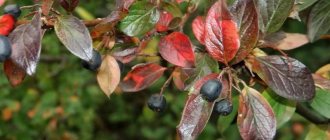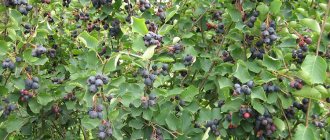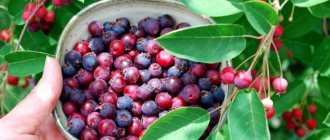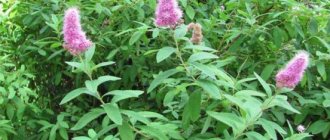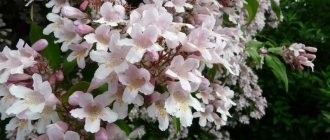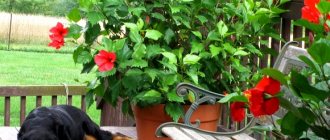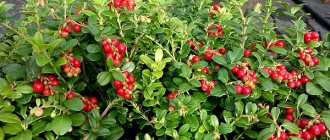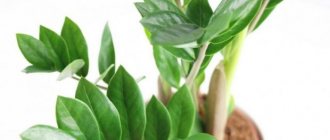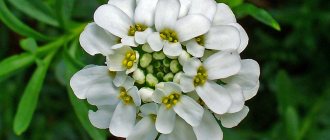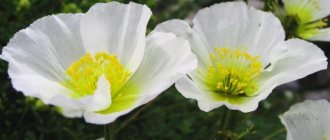Black cotoneaster: description
It is an evergreen deciduous shrub that grows rather slowly. Cotoneaster (Latin - Cotoneaster melanocarpus) is most often a small tree from the Rosaceae family. The name of the plant was given by the Swiss botanist Caspar Baugin. It consists of two words: cotonea, which is translated from Greek as “quince”, and aster - “similar, having the appearance”. This is due to the fact that the leaves of one of the cotoneaster species are similar to the leaves of quince.
The leaves of the plant are simple, not large, entire, alternate, ovoid in shape. In the summer they are dark green, and in the fall the color takes on a shiny reddish hue.
The flowers are pale pink or white in the form of small shields, single or collected in racemes. Flowering duration is up to twenty-five days.
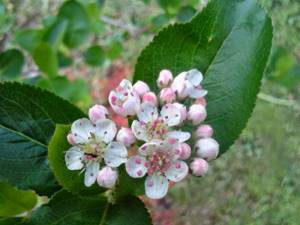
This plant is an excellent honey plant, and various crafts are made from its branches: pipes, canes, etc.
The fruit is a false drupe. The shape resembles a small black (or red) apple. Inside there are from two to five seeds. The fruits remain on the branches until late autumn, until the first frost. Shrub owners should know that chokeberry cotoneaster is fundamentally different from the similar dogwood. At the same time, its fruits are edible, which cannot be said about most other species.
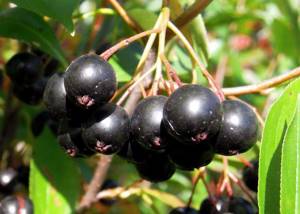
The use of cotoneaster in landscape design
The cotoneaster bush is very beautiful, so it is suitable for making amazing masterpieces from it in summer cottages - you just need to use your imagination a little.
- Using a hedge made from this plant, you can divide the area into zones.
- The bushes can be pruned to create wonderful topiary plantings.
- The common cotoneaster planted in a single planting is beautiful if your garden has a classic type.
- Cotoneaster, pruned in the form of pillows, looks great with other shrubs that are pruned similarly, in a single composition.
It is not recommended to plant common cotoneaster near any body of water - the plant does not tolerate excess moisture.
Landscape design lovers can use this shrub to express themselves, making their wildest desires come true.
Spreading
The plant has more than forty species that grow in North Africa and Eurasia. Chokeberry cotoneaster (you see the photo below) is frost- and drought-resistant. In addition, this plant is not demanding in terms of soil composition, lighting and humidity. The plant is widely distributed in cultivation: from Northern China to the Western regions, in Central Asia and the Caucasus, found in light deciduous forests and on mountain slopes. In Eastern Siberia, it grows under natural conditions singly or in groups.
Diseases and pests
Cotoneaster is resistant to pathogens, but weakened plants can still be affected by diseases (fusarium) and pests (yellow bear, aphids, moths). Parts of the plant affected by fusarium are removed and burned, healthy areas are treated with fungicides (for example, foundation), and the soil is treated with them.
To combat insects, insecticides of plant origin (yarrow, garlic, shag) or (in advanced cases) approved artificial preparations are used.
To prevent plants from getting sick, you need to follow the rules of agricultural technology: plant cotoneaster in well-ventilated places with full lighting and a low level of groundwater, shower the leaves to clean them from dust, remove damaged shoots in a timely manner, do not overfeed the bushes with nitrogen, especially after mid-summer.
Medicinal properties
Black cotoneaster is used as food, most often in compotes and soft drinks. Traditional healers use its medicinal properties to treat certain diseases, including:
- chronic and acute gastritis;
- diarrhea;
- gastroenteritis;
- fever;
- neurasthenia;
- jaundice;
- swelling;
- stressful conditions.
It is believed that for liver diseases it is necessary to take infusions and decoctions. The fruits are used in the treatment of epilepsy. Cotoneaster aronia successfully treats eczema and scabies. In Tibetan medicine, the properties of this plant are used to stop bloody diarrhea. An infusion of the fruit is a powerful antiseptic.
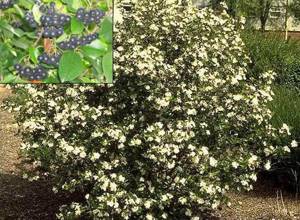
How to grow common cotoneaster
If you decide to start growing cotoneaster, you should know the varieties of cotoneaster, which can be:
- ordinary;
- shiny;
- chokeberry;
- multi-flowered.
The most popular is the common cotoneaster , which is used for landscaping cities and holiday villages located in central Russia. When you learn everything about this amazing plant, you will definitely want to grow it on your site.

Proper cultivation of common cotoneaster.
Black cotoneaster: planting
Seedlings are planted in early spring, when the ground has thawed and the buds on the trees have not yet opened. You can plant bushes in the fall. The time is chosen between the beginning of leaf fall and the first frost. Chokeberry cotoneaster feels quite comfortable in shade or partial shade. This will in no way affect the decorative qualities of the bushes. The plant is also not picky about soil quality.
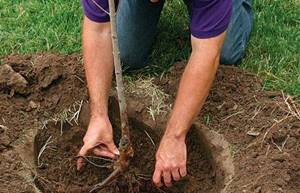
For cotoneaster you need a hole measuring at least 50x50x50 centimeters. It is covered with a layer of gravel or broken brick (20 cm). The soil mixture is prepared from peat, humus and sand (one part each) and turf soil (two parts). It will not be superfluous to add three hundred grams of lime to the soil mixture. The distance between cotoneaster bushes or buildings should be from fifty centimeters to two meters. This depends on the expected size of the plant crown.
When burying the seedling, make sure that the root collar is flush with the surface. Then the soil is compacted quite tightly, the tree trunk is watered abundantly and mulched. For this, it is best to use a layer of peat eight centimeters thick.
Cotoneaster brilliant: flowering and fruiting
Cotoneaster brilliant is a profusely flowering ornamental shrub. The buds begin to bloom at the end of May and continue throughout the month. Almost all of June the bush stands in a snow-white headdress, since the flowers are light in color with a reddish coating.
The buds are formed in the axils of the leaves, held on thin petioles, connected in several pieces. From this, a corymbose inflorescence is formed, consisting of 3-5 buds.
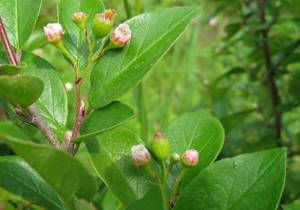
The flowers themselves are small and individually quite inconspicuous. However, opening simultaneously in large numbers, the buds against the background of greenery look especially attractive and give the plant additional decorativeness.
Each flower consists of five white petals located distant from each other. In the middle there are several stamens ending in red stigmas. Thus, the flower resembles a red ball with a white rim.
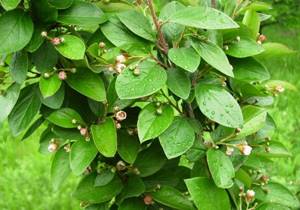
During flowering, the brilliant cotoneaster emits a fragrant aroma that attracts bees and other insects. With their help, pollination of buds and formation of fruit ovaries occurs. In order for this process to occur most intensively, it is recommended to plant fruiting and decorative cotoneaster bushes nearby.
In turn, the plant serves as an excellent means for beekeepers to obtain honey. If there are large thickets of cotoneaster near the apiary, then the bees do not need to fly anywhere else. From 1 hectare of such plantings you can collect up to 100 kg of useful products.
Plant care
Even a novice gardener can grow aronia cotoneaster. Caring for the plant is not difficult. The main thing you need to know about this plant is its categorical rejection of excess moisture at the roots. The cotoneaster will easily tolerate the remaining vagaries of nature.
Experienced gardeners assure that shrubs need watering very rarely, and if the summer is rainy, then it is better to forget about watering completely. In dry and hot summers, it will be enough to water the plant once every two weeks at the rate of eight buckets of water per adult plant. After rain (or watering), remove all weeds from the area and loosen the soil no deeper than fifteen centimeters.
LiveInternetLiveInternet
Friday, June 14, 2013 14:53 + in quote book Many types of cotoneaster are distinguished by their decorative beauty. Our article will tell you about the benefits of this unpretentious plant. Description of cotoneaster Cotoneaster is a non-thorny deciduous or evergreen shrub (less often a low tree). The plant belongs to the Rosaceae family. The shiny, ovoid, dark green leaves turn red in the fall - thanks to its decorative beauty, the plant can become a decoration for any garden. White or pink small flowers appear in May-June - they are collected in corymbs or racemes, but some species bloom with single flowers. Cotoneaster fruits are small in size. They can be red or black in color and each fruit contains from two to five seeds (not all types of this plant produce edible fruits). The Cotoneaster genus includes about one hundred species. They are distributed throughout Eurasia (40 species grow in the territory of the former USSR). Common cotoneaster is grown as a medicinal plant in our region. It is cultivated in the European part of the country, in Siberia and the Far East. Cotoneaster wood has long been used for crafts because it is highly durable. Chemical composition of cotoneaster Cotoneaster fruits contain ascorbic acid, as well as flavonoids and anthocyanins. The leaves are rich in phenolcarboxylic acids and vitamin C. Scientists have isolated a small amount of glycosides in their composition. Useful properties of cotoneaster Young shoots with leaves, as well as fruits, are used for treatment. The resin of this plant can cure scabies and eczema. The fruits have long been used for dysentery, diarrhea and flatulence. They are also useful in septic conditions. Nutritionists recommend consuming cotoneaster for gastroenterological patients. Herbalists prescribe the use of aqueous preparations of the plant, prescribing them for edema and liver diseases. The fruits are useful for metabolic disorders. They help with neuroses, hysteria, nervous fatigue and epilepsy. It is advisable to use a decoction of the leaves as a diuretic, and a decoction of the branches with unripe fruits and leaves - for jaundice. Methods for preparing cotoneaster The fruits of cotoneaster are not distinguished by high taste, however, they are added to tinctures and wines, as well as teas and other non-alcoholic drinks (to increase the benefits and to give a beautiful color). Powder from dried cotoneaster fruits is mixed with flour and gingerbread is baked, and candies and marshmallows are also made from it. Dried berries also have their uses. In general, harvesting cotoneaster for food purposes is not always advisable. More details here: https://mir-yagod.ru/zagotovka-kizilnika/ Contraindications to the use of cotoneaster So far, no serious contraindications to the use of edible types of cotoneaster have been identified (it is important to know that some types of this plant are poisonous). However, it is worth considering that this culture has not been fully studied. In addition, the possibility of developing negative symptoms due to individual intolerance cannot be excluded. In most cases, cotoneaster is grown as an ornamental crop. You can learn about the rules for breeding this useful and beautiful plant on our pages. © Mir-yagod.ru When copying site materials, keep an active link to the source. Types of cotoneaster Name: comes from the Greek 'cotonea' - quince, 'aster' - having the appearance of similarity between the leaves of quince and one of the types of cotoneaster. Description: deciduous or evergreen, densely branched shrubs, very often found in the landscaping of cities in the European part of Russia, especially in low hedges. The leaves are medium-sized, simple, alternate, entire, ovate, dark green in summer, turning red in autumn. The flowers are white or pink, small, in corymbs, racemes or solitary. The fruits are small, red or black. They grow slowly. In a permanent place they live for a long time, more than 50 years. They tolerate transplants and city conditions well. The genus contains about 40 species. Cotoneaster disticha Photo by Levon Vardanyan Cotoneaster horizontal Photo by Konstantinov Dmitry Cotoneaster salicifolius f. Repens Photo EDSR The main attractiveness of cotoneasters is the combination of strong branching, original foliage and a variety of growth forms (from erect to creeping). Small white or pink flowers are not very decorative, but are good honey plants. The dense crown of dark green shiny leaves that turn red in the fall is prized. These shrubs are simply irreplaceable when constructing hedges because they are easy to form, retain their shape for a long time and can be transplanted at any time of the season. In addition, at the end of summer, their decorative effect is enhanced by the abundance of bright red or black fruits that hang on the branches for a long time. The fruits are not poisonous and attract birds. Cotoneaster amoenus Photo by Marina Shimanskaya Cotoneasters are frost-resistant and drought-resistant. They develop well in urban conditions, as they are dust and gas resistant and have little demands on soil fertility and moisture. They grow well in both light and shade. They are propagated by seeds, which necessarily require stratification, as well as by layering, cuttings and grafting. They can be used as pear rootstock. Some species are sometimes damaged by green apple aphids, apple white moths, scale insects, sawflies, and cotoneaster mites. Many species can be recommended for decorative groups, plantings on slopes, slopes, retaining walls and alpine slides, for hedges, but only a small number of species are used in culture. Three species - brilliant cotoneaster, black-fruited and whole-edged - have high winter hardiness and are especially resistant to the vagaries of weather in central Russia. Shiny cotoneaster - C. lucidus Schlecht. The homeland of this species is Eastern Siberia. Grows singly or in groups in bushes. Light-loving mesophyte, microtherm, mesotroph, assectator of shrub groups and, less often, undergrowth of light-coniferous forests. Everywhere in culture. Densely leafy, upright, deciduous shrub, up to 2 m tall, with densely pubescent young shoots. Elliptical leaves are pointed, up to 5 cm long, shiny, dark green, purple in autumn. Pink flowers are collected in loose, 3-8-flowered, corymbose inflorescences. Blooms in May - June for 30 days. Decorative, almost spherical, black, shiny fruits, with brown-red, tasteless pulp, remain on the bushes until late autumn. Fruits from the age of 4 years. Winter-hardy, unpretentious to soils, shade-tolerant. Propagated by seeds and vegetatively. Seeds require 12-15 months of stratification, which can be shortened by treating them with sulfuric acid for 5-20 minutes, followed by stratification for 1-3 months. Seed sowing rate 5 g/sq. m. One of the best shrubs for creating hedges formed by pruning, as well as for group planting on lawns, edges, and as undergrowth. Suitable for landscaping cities throughout almost the entire territory of Russia. In culture since the beginning of the 19th century. Photo by Alexandra Shcherbakova, Black cotoneaster - C. melanocarpus Fisch. ex Btytt Has good winter hardiness in central Russia. In the wild it grows quite widely from Central Europe to Northern China, including the Caucasus and Central Asia, in light forests and along mountain slopes, rising to the subalpine zone. It grows in the shrub layer of different types of forests and participates in the creation of shrub thickets on screes and rocks. Light-loving mesophyte, microtherm, mesotroph, assectator of undergrowth of bushes. Protected in nature reserves. This shrub, up to 2 m high, with red-brown shoots, like the previous species, has black fruits, but differs in leaf shape. Ovate leaves 4.5 cm long, dark green above, white-tomentose below, with a blunt or notched apex. Starting from the age of 5, it blooms and bears fruit annually. Flowering lasts almost 25 days, pink flowers are located in the axils of the leaves, 5~12 pieces per shoot, forming loose clusters. The spherical fruits, ripening in September-October, gradually turn from brown to black with a bluish coating. Frost-resistant species, not demanding on soil and moisture, grows well in shaded areas and in urban environments. It easily tolerates transplantation and is propagated by cuttings and seeds. In cultivation since 1829, it is used in hedges, less often in single and group plantings. There is a known decorative form (f. laxiflora) with loosely flowered drooping inflorescences and larger leaves. In addition to decorative purposes, this species is a good honey plant, and its hard wood serves as material for canes, pipes and other crafts. Photo by EDSR. Cotoneaster entire, or common - C. integerrimus Medik. In nature, it can be found from the Baltic states in the north to the North Caucasus in the south. It grows on mountain slopes and screes, on outcrops of sandstones, shale and limestone. Light-loving xeromesophyte, microtherm, mesotroph, assectator of shrub thickets. Protected in nature reserves. Rarely in culture. An upright, highly branched, deciduous shrub up to 2 m tall, with a rounded crown. Young shoots with woolly drooping, later glabrous. Broadly ovate, up to 5 cm, leaves, dark green above, shiny, smooth, gray-felt below. The flowers are pinkish-whitish in 2-4-flowered drooping racemes. The fruits are bright red, up to 1 cm in diameter. Undemanding to soil, grows well on calcareous soils. It is characterized by high winter hardiness. Grows better in sunny places, drought- and gas-resistant. It is especially effective in fruits that remain until late autumn. Used for planting in groups, hedges, edges, in cities in the northern and central regions of Russia. In culture since 1656. Photo by EDSR. The following species - multifloral cotoneaster, racemosa and pink - are more demanding in choosing a place; in very harsh winters they can partially freeze, but they are saved from death by their high ability to regenerate. Multiflorous cotoneaster - C. multiflorus Bge. It is found naturally in the Caucasus, Central Asia and Western Siberia, and Western China. It grows singly or in small groups in forests, as well as in bush thickets. Light-loving mesophyte, micromesotherm, mesotroph, assectator of undergrowth of bushes. Protected in nature reserves. In cultivation it is found in botanical gardens in Europe. Semi-evergreen shrub up to 3 m tall, with thin, tomentose, curved branches when young. Broadly ovate leaves up to 5 cm long, silver-gray in spring, dark green in summer, purple-red in autumn. Less frost-hardy than brilliant cotoneaster. Quite large white flowers (up to 1 cm), similar in shape to serviceberry flowers, are collected in 6 - 20 corymbose inflorescences and make it very spectacular during the flowering period lasting from 16 to 25 days. Bright red, abundant, spherical fruits enhance its decorative value in autumn. Fruits from 5 to 6 years of age. The fruits ripen in August. Frost-resistant and drought-resistant. For successful development it needs fertile and lime-rich soil. Propagated by seeds. The seed sowing rate is 4 - 6 g per meter. Very good in single and edge plantings. Since 1879, it has been widespread throughout the European part of Russia. It has a beautifully fruited form (f. calicarpa) - with narrower and longer leaves than the typical form and larger, up to 1 cm, abundant fruits. Photo by Kirill Kravchenko Cotoneaster racemiflorus It is promising for central Russia. It is less known in culture than previous species. This is a shrub up to 3 m high, with medium-sized bluish-green leaves. Young shoots and leaves are covered with thick white-tomentose pubescence on the underside. Small white-pink flowers are collected in inflorescences of 7-12 pieces, covering the entire bush in May. The first flowering occurs at 4 years of age. In August, when numerous elliptical or spherical bright red fruits ripen, the shrub becomes even more elegant. The fruits do not fall after leaf fall and hang on the bush until the first snow. Pink cotoneaster - C. roseus Edgew. Homeland - northwestern Himalayas. Grows on mountain slopes. Mesoxerophyte, mesotroph, micromesotherm. A very rare decorative species in culture. A shrub up to 1.5 m high with thin shoots, elliptical leaves up to 6 cm long and small pink flowers collected in inflorescences of 9 pieces. It blooms for the first time at the age of 8. It blooms profusely in June for 3-4 weeks, but does not bear fruit every year. In October, 2-3 seeds ripen in round pink-red fruits with a diameter of up to 6 mm. It is very decorative during flowering (in June) and especially in autumn with fruits that, ripening at the end of September, decorate the plants until lasting frosts. Propagated by seeds and green cuttings. Less winter-hardy than brilliant cotoneaster; During severe frosts, the tops of the shoots freeze. Requires sanitary pruning annually. Photophilous, resistant to diseases and pests. Recommended for decorative groups and solitary plantings. All other types of cotoneasters are even more whimsical and are damaged by frosts in central Russia, if they are not covered with snow in snowless winters. But they winter well under the snow and do not freeze above the snow cover, and they also have a high regenerative ability. Single-flowered cotoneaster - Cotoneaster uniflorus Bunge Branch with fruits. Altai Republic, North Chuysky ridge, river valley. Aktur, altitude about 2000 m above sea level. August 18, 2010 Alexander Simushkin Growing in the mountain forests of the Urals, Altai and Western Sayans. Grows on rocky slopes as part of bush thickets. Light-loving psychrophyte-petrophyte, facultative calcephyte, hexistomicrotherm, occasionally assectator of the shrub layer. Protected in nature reserves. It is low (about 50 cm), spreading, and in harsh conditions it acquires a creeping growth form. The leaves are up to 3 cm long, dark green above, yellowish below. In autumn the leaves turn bright red. Flowering in the culture occurs in the 8th year. Single flowers are located in the axils of the leaves, which is why it is called single-flowered. The fruits are bright, orange-red, spherical in shape. This species is rarely found in culture. For cultivation, select places protected from cold winds. Does not tolerate drought and bright sunlight. Recommended for planting in borders. Pressed cotoneaster - C. adpressus Bois. Found naturally in the western regions of China. It received this name due to its prostrate growth form and shoots pressed to the ground. Individual branches are capable of rooting. A low-growing, creeping shrub, with small, up to 1.5 cm long, dull green leaves, on branches rising above the ground. During flowering, it is decorated with numerous pink flowers; in autumn, the crown is colored with spots of bright red fruits. The shrub blooms and bears fruit from the age of 9. Propagated by seeds and layering. The garden form “Early” (var. praecox) is known. Very effective in single and group plantings on rocky hills. Recommended for the southern and western regions of the European part of Russia. In culture since 1896. Stable, but overwinters only under snow. Photo by EDSR. Horizontal cotoneaster - C. horizontalis Decne C. horizontalis Photo by Denis Kudryavtsev Originally from Central China. Grows on mountain slopes. Widely distributed in culture, both in the collections of botanical gardens and in the landscaping of cities in Europe, North America and East Asia. The name of the species indicates the nature of its growth. This is an evergreen shrub up to 50 cm high, with horizontally outstretched, almost pressed to the ground, pinnately branched shoots located in the same plane. Its small, almost round, up to 1.5 cm, dark green leaves, purple in autumn, are remarkable. The flowers are single or paired, sessile, with pinkish-reddish petals. It blooms from late May to mid-June, for three weeks. The fruits are spherical with a diameter of 4-5 mm, bright red, shiny, ripen in September and remain en masse until December, in the lower part of the bush - even until the spring of next year, giving the plants a special decorative appearance. Drought and gas resistant. This species is demanding on soil fertility. It grows quickly and expands greatly, the crown diameter is more than 1 m. It is light-loving. One of the most elegant views. First introduced into culture in 1880. Widely used in the southern half of European Russia. In the north it freezes, but near St. Petersburg it winters under snow, with light shelter. An excellent ground cover plant, including for rocky gardens, for strengthening slopes, and cascade (terrace) landscaping. In the photo on the left is Cotoneaster horizontalis f. 'Variegatus' (C. atropurpureus 'Variegatus'). 'Vatropurpureus' Photo by Konstantin Korzhavin This prostrate, up to 30 cm tall and more than 1.5 m in diameter (after 5 years of cultivation) evergreen shrub is especially beautiful in the fall, when small leaves turn red, pink with a cream border. Each leaf (1.5 cm long) has a white stripe along the edge. Decorative bright red shiny round fruits. 'Perpusillus'. 'Perpusillus' Photo by Natalya Zakutnaya Prostrate shrub 15-20 cm tall covers an area up to 0.5-1 m in diameter. It grows quite slowly. Blooms with pink flowers in early summer. At the end of summer, scarlet berries appear. In autumn, the dark green leaves turn purple and the bush looks very beautiful. Dammer's cotoneaster - C. dammerii CK Schneid. The photograph of Natalia Pavlova is more spoiled in a temperate climate, looks like the previous look. In the wild, it grows in the mountains of central China. The creeping shoots of the shrub are almost pressed to the ground and partially rooted. They branch in one plane, rising only by 20-30 cm, and grow to the sides by a distance of 1.5 m. Dark green leathery leaves with a dull peak look like evergreen and do not fall for a long time. The leaves are very small, elliptical, up to 2 cm long. Small reddish flowers sitting on twigs are good. In September, the ripening and long-not falling numerous coral-red fruits with a diameter of up to 6 mm, closely located on shoots, are very well combined with brilliant foliage. In late autumn, the plant becomes even more colorful thanks to bright fruits and purple leaves. The Dammer tacing is propagated by seeds, layering and cuttings. He is drought to resist, hibernates under the snow and does not freeze. It grows well on light rocky, poor sandy soil. It prefers a solar location, but also makes a slight shading. It grows rapidly. The characteristic appearance (gabitus) and the way of shooting shoots have been known in culture since 1900 make this shrub irreplaceable for alpine slides and the arrangement of retaining walls. Varieties: 'Coral Beauty'-40-60 cm high with orange-red fruits. 'Eichholz'-20-40 cm high with single, large, red fruits. The most frost -resistant variety. 'Stogholm'-80-100 cm high with bright red fruits. 'Steib's Findling' Photo of Oak Galina Kizilnik Henry - S. Henryanus rehd et wits. Homeland Western China. Representative of the group of evergreen kizilniki. The shrub, reaching 5 m of height, has a beautiful, shabby crown and long curved shoots. The leaves are oblong, up to 12 cm long, dark green, brilliant, from below, initially grayish-wound, later grayish-green. White, fragrant flowers up to 1 cm with purple dust agents are collected in shit -shaped inflorescences. Dark-pocket, colorful fruits decorate plants in the fall. Grows quickly. One of the most beautiful species. Decorative all year round-a shaky crown, a dark green shiny foliage, against which the old leaves are beautifully distinguished in the autumn, taking orange before falling. Spectacular during flowering. Used in single and group landings in the south of Russia. In culture since 1901. Bubble dumplings - S. bullatus bois East Asia. Introduction in 1898. A deciduous shrub is up to 3 m of height. It got its name thanks to the dark green glossy, which makes the impression of wrinkled leaves. In the fall, before the leaf fall, they are painted in bright red tones. Photo from the book by Karin Grainer, Angelika Weber “Flowers, decorative shrubs and trees in our garden” numerous light red spherical apples with clusters hang from branches on long petioles. The plant is winter -hardy up to -23 degrees, so it often freezes to the level of snow cover. Kiznik Franche - S. Franchetii Bois photography of Olga and Viktor Riis Central China. Grows along the slopes of the mountains. Feat -loving meosurophyte, mesotroph, mesoterm. Shrub up to 2 m high. In GBS, 1 sample (4 copies) is grown from cuttings obtained from plants grown in the GBS. At 9 years old, a height of 1.5 m, the diameter of the crown 120 cm. Vegetates from mid -April to mid -October. The growth rate is average. Doesn't bloom. Winter hardiness is low. 5-7% of cuttings are rooted. Location: they develop better in areas with full lighting, but also take part. Soil: to fertility and soil moisture are little -related. However, the following soil composition is recommended: turf soil, peat component, sand in a ratio of 2: 1: 2. A multi -flowered kizilnik needs a lime of 300 g/sq. m. Planting: the distance between plants 0.5 - 2 m depending on the diameter of the crown of an adult plant. Planting depth 50 - 70 cm: root neck at ground level. Drainage is required (gravel or broken brick, with a layer of 10 -20 cm). Care: in the spring, complete mineral fertilizer is made: Kemiro-UNIVERSAL at the rate of 100-120 g per 1 square. m or 20 -30 g of urea per 10 liters of water. In summer, granular superphosphate 60 g/sq. mi 10 - 15 g/sq. m of potassium sulfate. Many species of the diver are drought tolerant and watering do not require, or it is needed only in very dry summer, 1-2 times a month of 8 liters of water per plant. Lubrication is carried out shallow (10 - 15 cm) after weed removal. After planting seedlings, mulching is made with peat, a layer of 5-8 cm. Kizilniki successfully lend themselves to molding, dense hedges of medium heights are formed. After trimming, they grow strongly, preserving the form of growth. Pruning is allowed 1/3 of the length of the annual shoot. Tags winter with a light shelter with a dry leaf or peat with a layer of 3 - 6 cm or under the snow. Sometimes for the winter, branches are bent to the ground to protect flower buds from frost. Protection against pests and diseases: Fusariosis. Remove and burn the affected parts of the plants. Disinfection of the soil is carried out or the planting area is changed with a strong spread of the disease. With a bear yellow, they fight spraying any of the phosphoruscorganic insecticides. Against aphids-more emergency spraying the DNA or nitrate. According to larvae, sprayed with carbophos, metaphos, corn, saphos. If necessary, spraying is repeated. Belon is used from plant infusions of black, tall, potato tops, yarrow, master, mahorka, etc. Against moths after flowering and in the summer period are sprayed with: amphosis, carbophos (0.1 - 0.4%) or horn (0.2 %). The most effective are fosalon (0.2%) or Gardon (0.1-0.35%). During flowering, entobacterin is used, conducting two- or three-time processing with an interval of 12-14 days. Propagation: seeds, layering, cuttings, vaccination. The seeds, as a rule, have a very low germination (40 - B0%). Involved seeds when washing pop up and must be discarded. The remaining seeds should be sown and remember that they have a long period of rest and germinate very difficult. They need to be stratified and sown in the fall of next year. When propagated by green cuttings, a high percentage of rooting is obtained when the cuttings are closed by the film. The best time for cuttings is the second half of July. The substrate consists of a mixture of peat and sand taken in equal amounts. Using: very valuable decorative shrubs due to the dense crown, shiny dark green leaves and bright numerous fruits, which are stored for a long time on the branches. It is recommended for edges, groups, single plantings on the lawn, borders and dense hedges. Some types of PSPs are ioles for the formation of a undergrowth, on rocky slides, slopes. Used sources: https://mir-yagod.ru/kizilnik/ https://flower.onego.ru/kustar/cotoneas.html
| Categories: | Flora, stories about plants Dachnoye My messages |
Tags:
Ornamental shrubs: Cotoneaster (COTONEASTER)
Cited 11 times Liked by: 2 users
Like share
0
Like
- 2
I liked the post - Quoted
- 0
Saved
- Add to quote book
- 0
Save to links
Liked2
0
Top dressing
In the first days of spring, when the temperature reaches above zero, the cotoneaster should be fed with nitrogen fertilizer. You can use urea (25 g) diluted in ten liters of water. Kemiry-universal granules (long-acting) are also suitable. Before flowering, feed the plant with 15 g of potassium and 60 g of superphosphate per square meter of soil. At the end of the season, the planting circle is mulched using peat (or covering material).
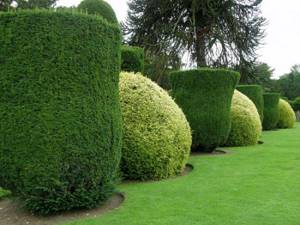
Dogwood in cosmetology
In the field of cosmetology, masks and scrubs from dogwood fruits are actively used (the bark is used only in anti-inflammatory masks). From the pulp of this plant you can prepare a natural, moisturizing and inexpensive vitamin mask for skin and hair at home, and from the seeds you can make a scrub for the face and body.
Creams and masks with dogwood extract perfectly tone and moisturize the skin, cleanse pores, eliminate oily shine, blackheads, and wrinkles. Rinsing with dogwood decoction makes hair silky and also gets rid of dandruff.
Mask for the face
A very effective remedy for fighting wrinkles is this mask:
Ingredients:
- 30 g of fresh dogwood berries;
- 30 g banana pulp;
- 10 g oatmeal;
- 10 g potato starch.
Preparation:
- Mix all ingredients well, bring to a mushy state.
- Let it brew for 3-5 minutes.
Apply this mask for 30 minutes, then rinse with warm water. It is recommended to use this product daily, in the morning or evening. The effect will appear after 5 days of using this mask.
For dry skin, it is recommended to exclude cereals and starch, but add olive oil
Dogwood is an amazing plant: it is not only actively used in folk medicine, cosmetology and cooking, but is also useful in everyday life, and is also a beautiful shrub that can decorate even the most skillful garden plot.
This “red doctor,” as people say, can cure thousands of diseases, and its rich chemical composition, as well as the enormous beneficial effect it has on the human body, fully corresponds to this opinion.
Pruning cotoneaster
Bushes are responsive to pruning. This is exactly the plant that designers use to form bushes of various shapes: prism, cone, hemisphere and even more complex shapes. It is recommended to prune by a third of the growth of the annual shoot. Curly pruning will require special tools and certain skills. After pruning, the shoots quickly grow back, but the shape given to the bushes is preserved.
Pruning cotoneaster can also perform a sanitary function, since sick, old, broken branches appear on any bush from time to time.
